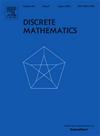Further results and questions on S-packing coloring of subcubic graphs
IF 0.7
3区 数学
Q2 MATHEMATICS
引用次数: 0
Abstract
For a non-decreasing sequence of integers , an S-packing coloring of G is a partition of into k subsets such that the distance between any two distinct vertices is at least , . We consider the S-packing coloring problem on subclasses of subcubic graphs: For , a subcubic graph G is said to be i-saturated if every vertex of degree 3 is adjacent to at most i vertices of degree 3. Furthermore, a vertex of degree 3 in a subcubic graph is called heavy if all its three neighbors are of degree 3, and G is said to be -saturated if every heavy vertex is adjacent to at most i heavy vertices. We prove that every 1-saturated subcubic graph is -packing colorable and -packing colorable. We also prove that every -saturated subcubic graph is -packing colorable.
求助全文
约1分钟内获得全文
求助全文
来源期刊

Discrete Mathematics
数学-数学
CiteScore
1.50
自引率
12.50%
发文量
424
审稿时长
6 months
期刊介绍:
Discrete Mathematics provides a common forum for significant research in many areas of discrete mathematics and combinatorics. Among the fields covered by Discrete Mathematics are graph and hypergraph theory, enumeration, coding theory, block designs, the combinatorics of partially ordered sets, extremal set theory, matroid theory, algebraic combinatorics, discrete geometry, matrices, and discrete probability theory.
Items in the journal include research articles (Contributions or Notes, depending on length) and survey/expository articles (Perspectives). Efforts are made to process the submission of Notes (short articles) quickly. The Perspectives section features expository articles accessible to a broad audience that cast new light or present unifying points of view on well-known or insufficiently-known topics.
 求助内容:
求助内容: 应助结果提醒方式:
应助结果提醒方式:


